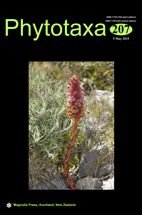Abstract
Seven new Haslea species demonstrate that the genus has evolved a richer morphological repertoire than so far reported. H. feriarum sp. nov. has a valve contour suggesting an Amphora; H. staurosigmoidea sp. nov. has a sigmoid valve with a pseudostauros; H. tsukamotoi sp. nov. and the closely similar H. meteorou sp. nov. possess uniquely shaped external central raphe endings and a fully sideways-tilted internal raphe system; H. clevei sp. nov. and H. avium sp. nov. also have central raphe ending shapes not yet described in the genus; H. amicorum shows interrupted longitudinal fissures besides the continuous fissures characteristic of Haslea. A survey of the Haslea species described, for differentiation of our taxa, led to two conclusions: 1) the data in the protologue of H. indica Desikachary & Prema are spurious and 2) “Navicula” duerrenbergiana Hustedt is here transferred to the genus Haslea. The basic Haslea morphology is a sandwich-type valve, with a grate-like inner layer (here called basal layer) and an outer layer (here called tegumental layer) perforated by continuous longitudinal fissures. These two layers are shored by upright longitudinal “bulkheads”, here called saepes, seen to be perforated in the valves that permitted their observation. This morphology is closely similar to that of Gyrosigma (and Pleurosigma). The great variety of central external raphe ending patterns in Haslea, Gyrosigma and Pleurosigma is shown and discussed.

